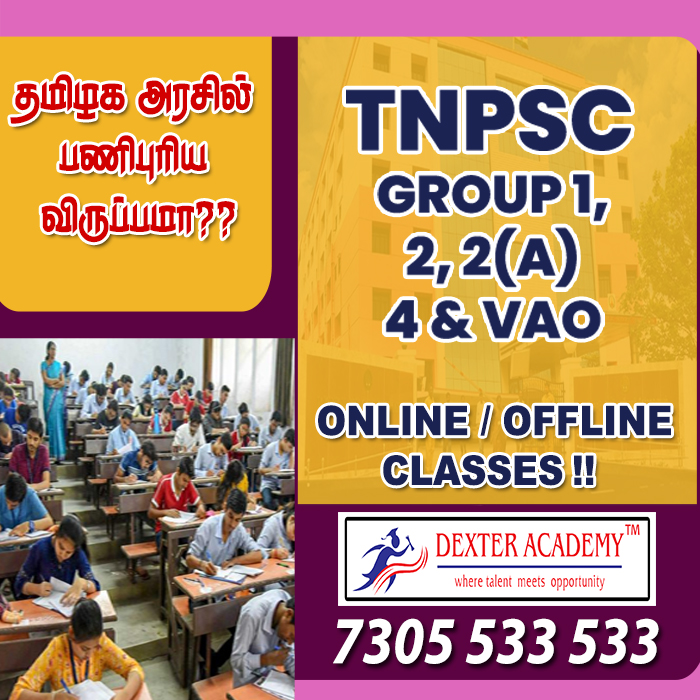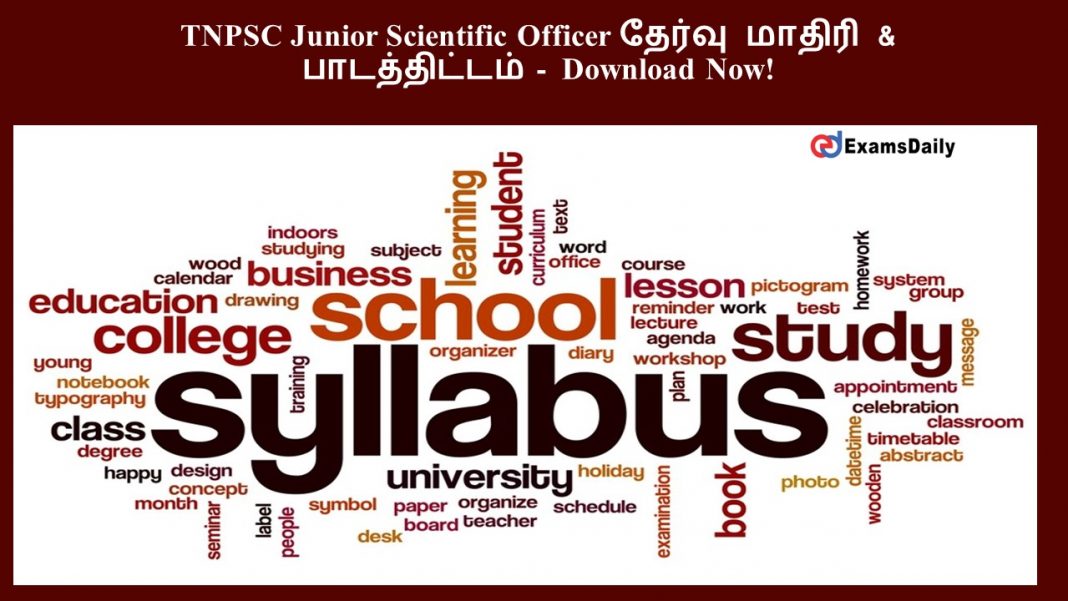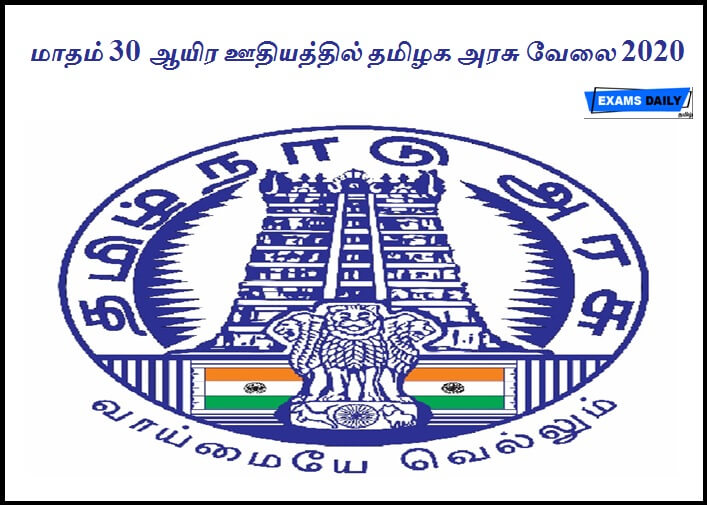TNPSC Junior Scientific Officer தேர்வு மாதிரி & பாடத்திட்டம் – Download Now!
தமிழ்நாடு அரசு பணியாளர் தேர்வாணையம் ஆனதுJunior Scientific Officer பணியிடங்களை நிரப்புவதற்கான அறிவிப்பை தற்போது வெளியிட்டுள்ளது. இதற்கான தேர்வு மாதிரி & பாடத்திட்டம் பற்றிய முழு விவரங்கள் கீழே தொகுத்து வழங்கப்பட்டுள்ளது. அதன் மூலம் தேர்வர்கள் தங்களை தயார் படுத்தி கொள்ளுமாறு கேட்டுக்கொள்ளப்படுகிறது.
- Computer Based Test (CBT)
- Oral Test
TNPSC JSO தேர்வு மாதிரி:
| Subject | Duration | Maximum marks | Minimum qualifying marks for selection | |
| SCs, SC(A)s, STs, MBCs/DCs BC(OBCM)s & BCMs | Others | |||
| Paper –I:-(PG Degree Standard) (200 Questions)
1) Forensic Science(Code No.226) 2) Biology (Code No.227) 3) Chemistry (Code No.228) 4) Physics (Code No.229) 5) Computer Science(Code No.287) |
3 Hours | 300 | 153 | 204 |
| Paper – II:- Part-A
Tamil Eligibility Test (SSLC Standard) (100 questions/150 marks) |
3 Hours | 150Note: Minimum qualifying marks – 60 marks (40% of 150) Marks secured in Part-A of Paper-II will not be taken into account for ranking. | ||
| Part-B(General Studies)
(Code No:003) (100 questions) (150 marks) General Studies (Degree Standard) – 75 questions and Aptitude and Mental Ability Test (SSLC Standard) – 25 questions iii. Interview and Records |
150
60 |
|||
| Total | 510 | |||
TNPSC Junior Scientific Officer பாடத்திட்டம்:
PAPER-I
SYLLABUS
FORENSIC SCIENCE (PG DEGREE STANDARD)
UNIT- I:
Forensic Science – Definition – Development of Forensic science in India – Organization and functions of Forensic laboratory
UNIT- II:
- Physical evidences – their classification and significance – Locard’s Principle of exchange- class and individual characteristics.
- Crime Scene examinations – documentation of crime scene- recognition, collection, preservation and transportation of physical evidence for laboratory examinations.
- Fundamentals of photography – crime scene photographyUNIT – III:Foot and tyre impressions – Walking pattern – Recording and examination of foot prints and tyreprints. Finger prints – Fundamental principles – Finger print patterns – classification of finger prints – methods of developments of latent finger prints.
UNIT- IV:
- Tool marks – identification – restoration of filed off/erased marks – Detection of counterfeit coins and currency.
- Fire arms, Bullet and cartridge case identification – pellets and wads – Range of firingUNIT- V:
- Fire and arson – Natural fires – Arson – Accelerants – Combustible properties of flammable substances.
- Explosives – Classification of explosive substances – Combustion, detonation and explosion – Effectsof explosion – Military and industrial explosives – Improvised explosive devices – Explosive residues -Residues examinationUNIT- VI:Questioned documents, identification of hand writing, type writer and forged signatures – Erasures and alterations on documents and their detection
UNIT – VII:
- Broken glass – glass fractures – direction of force – backward fragmentation – comparison of glass fragments.
- Forensic examination of soil and paints, Theory and practice of polygraph and voice identificationUNIT- VIII:Toxicology – classification and mode of action of poisons – narcotic drugs – alcoholic beverages – isolation and identification of poisons, drugs and alcohol
UNIT- IX:
-
Examination of biological fluids – blood, seminal and saliva stains – forensic characterization of the above stains – stain patterns of the blood, Examination of fibres, hair, bones, teeth and skull – Fundamental of DNA typing.
UNIT- X:
- Instrumental methods of organic analysis – principles of chromatography, spectrophotometry, and mass spectrometry.
- Instrumental methods of inorganic analysis – Principles of emission and atomic absorption spectra – X-ray diffraction – Neutron activation analysis.PAPER-ISYLLABUS
BIOLOGY (PG DEGREE STANDARD)
UNIT- I:
-
General classification and salient features of Invertebrata and vertebrata – Metamorphosis and regeneration in lower forms of animal – Economic importance of oyster, honey bee, Silkworm – Agricultural pests and their control – Larval forms of crustacean and Echinodermata – Classification and identification of poisonous and nonpoisonous snakes and types of snake venom.
- Evolution: Theories, types and factors influencing evolution Evidences of human evolution – Human genetics: Pedigree analysis, lod score for linkage testing, Karyotyping, Significance of human genome project.
UNIT- II:
-
Structural organization and importance of animal cells – Muscle cells – Cardiac, Striated and non-striated muscle cells– Hepatocytes Neurons, Nephrons, Karatocytes, immune and endocrine cells.
- Functions of hormones and their receptors – Impact of sex hormones in human behavior. Chronobiology: importance of circadian rhythm and human biological clock – DNA analysis inpaternity testing – Cell counting of WBC and RBC.Functions and disorders of Digestive, Respiratory, Cardiovascular Nervous, Muscular, Excretory, Reproductive and Integumentary systems.
- Developmental biology: production of sperm and egg, Fertilization – Zygote, Cleavage. Blastulation, gastrulation and formation of germ layers in animals and organogenesis –determination of sex by Amniocentosis. Entomology: Insect classification – Beneficial and harmful insects – Role of insects in decomposition of decayed materials – Exploiting insect olfaction in forensic studies – Importance of ants, blowflies and beetles in forensic investigation.
UNIT – III:
-
Fundamentals of Anthropology Meaning – Scope and branches of Anthropology – Basic concepts / principles of Physical or Biological Anthropology – Anthropology and its relation with other Social, Biological and Medical Sciences – Analysis of kinship – Health and Ethno medicine – Population dynamics with special reference to Tamil Nadu – Applied and developmental Anthropology – Tribal, Rural and Urban Communities Research Methodology- Anthropological research – Fieldwork Tradition, Methods and Techniques, Qualitative and Quantitative research Methods, Observation, Case study, Ethnography, Life histories and Personal documents, Visual Anthropology, Genealogical Methods.
UNIT – IV:
Physical / Biological Anthropology Position of human being in the animal kingdom – Human Evolution – Theories of human evaluation, Human growth and development – Factors affecting for growth, Demographic growth variation, Sex and Gender – Bio-cultural dimensions, Race and Ethnicity – Major racial groups of India, Ethnicity and contemporary relevance – Applied physical anthropology – Anthropometry and its uses, DNA Technology, genetic diseases, Forensic Anthropology and criminal investigations.
UNIT-V:
-
Chemistry of Biomolecules Carbohydrates – Structure and functions [Mono,Di &Polysaccharides] – Disorders of Carbohydrate Metabolism and its laboratory diagnosis. Proteins and Amino acids – Types, structure and function. Lipids – Types structure and functions.
- Sterols –Cholesterol.Disorders of lipid metabolism and its laboratory diagnosis. Nucleic acid – DNA – Types, structure and functions RNA – Types, structure and functions Enzymes – Classification and properties of enzymes, Coenzymes, Marker enzymes Hormones- Classes and functions of hormones
UNIT-VI:
-
Biochemical and Molecular Techniques Blood and its composition – WBC, RBC and Platelets. Blood clotting, Blood grouping, Crossmatching and compatibility tests, Blood smear analysis, HLA typing. Antigens and Immunoglobins – Classes and functions. Collection and Preservation of Biological fluids [Blood, Urine, CSF, Amniotic fluid, Semen, Sputum and Saliva].
- Normal and Abnormal constituents of Biological fluids. Isolation of DNA from blood sample, Agarose gel Electrophoresis, PCR,DNA Sequencing, RAPD,RFLP, DNA Finger printing -STR Typing. Isolation of Proteins from blood sample, SDS PAGE, RIA, ELISA, FISH. Ames test, Comet Assay.
UNIT- VII:
-
Origin of Microbiology, Contribution of Louis Pasteur, Alexander Flemming, Waksman, Robert Koch.Microscopy; Brightfield, Phase contrast, Fluorescent, Electron Microscopy and Confocal Microscopy. Staining techniques.
- Cultivation of Microorganisms, Preparation of culture media, Sterilization techniques, Preservation techniques, Identification of Microorganisms; Conventional and Molecular techniques. Host parasite interaction, Microbial diseases, Nosocomial infection, Zoonotic diseases, Food borne diseases, Microbial diseases of medical negligence. Bioterrorism and Biohazards.
UNIT- VIII:
-
DNA profiling, Genetic code, Mutation and DNA polymorphism, Microbial nanotechnology, Infectomics.
- Biodeteriotion of fibres and leather, Bioremediation, Bioconversion – Biogas technology, Environmental microbiology – Microbiology of air, water and soil. Role of microbes in production of fermentation products. Production of antibiotics, Enzymes, Pigments, Insulin, Interferon, Monoclonal antibodies and GrowthHormones. Recombinants DNA technology. Microbial biofertilizers, Microbial biopesticides and Microbial degradation of synthetic pesticides.
UNIT – IX:
- Plant Diversity, Cell Biology – Taxonomy and Paleo botany, Plant PhysiologyPlant biochemistry,Plant pathology Plant Diversity – Algae, Fungi, Bryophyte, pteridophytes, Gymnosperms, lichen.
- Cell Biology – Cell structure and functions Taxonomy– Principals of Taxonomy and phylogeny of angiosperms, Nomenclature of plants, Monocotyledons and dicotyledons Paleo botany – Fossil plants Plant Physiology and Plant biochemistry – Ezymes, Protein, Aminoacid and photo synthesis, respiration Plant pathology – Bacterial, Fungal and Viral Diseases of Plants.
UNIT- X:
-
Plant Anatomy, Embryology, Genetics, Economic Botany, Ethnobotany, Environmental Botany Plant Anatomy – Cell cycle, Cell division, Tissue system and secondary growth, Fruit wall and seedcoat. Embryology – Embryogenesis, Polyembryony, Double fertilization, Somatic Embryogenesisand Pollen grains.
- Genetics – Mendelism, Linkage, crossing-over, chromosome mapping, RAPD and RFLPTechniques. Economic Botany – Wood and Wood products, Fatty Oils and Vegetable Oils. Tannins and Dyes. Ethnobotany – Ethno Medicinal Plants, Narcotic Plants. Environmental Botany – Plant adaptations, Hydrophytes, Xerophytes, Mesophytes, Epiphytes,Halophytes and Mangrove vegetation. Ecological Indicators, Forest and Forest Management
PAPER-I
SYLLABUS
CHEMISTRY (PG DEGREE STANDARD)
Unit – I:
- Quantum Chemistry :Quantum mechanical postulates – Eigen value and function – the Schrodinger wave equation – elementary applications of Schrodinger’s equation – the particle in a box (one, two and three dimensional cases) – particle in a ring.
- The harmonic oscillator –the rigid rotor – the hydrogen atom – the Schrodinger equation for hydrogen atom – angular momentum – term symbols – Approximation methods – perturbation and variation method – application to hydrogen and helium atoms – R.S. coupling and term symbols for atoms in the ground state – Slaterorbital and HF – SCF methods Born open – Heimer approximation – valence bond theory for hydrogen molecule – LACO – MO theory for di and polyatomic molecules – concept of hybridization – Huckel theory for conjugated molecules (ethylene butadiene and benzene) – semi empirical methods.Unit – II:
- Chemical Kinetics and Thermodynamics: Rate laws – rate constant for first, second, third and zero order reaction – Half life period Temperature dependence on rate – Arrenhenius theory – collision theory – Absolute reaction rate theory – ionic reaction – salt effect – catalysis – Laws of photo chemistry, quantum efficiency – photo physical processes of electronic excitedmolecules.
- Partial molar properties – Chemical Potential – Partial molar volume and molar heat content – significance and determination – Thermodynamics of real gases – gas mixture – fugacity definition – determination of fugacity variation of fugacity with temperature and pressure – concept of thermodynamic probability – distribution of distinguishable and non – distinguishable particles.
- Maxwell – Boltzmann, Fermi-Dirac and Bose Einstein statistics – modes of contribution to energy – partition function – translational, vibrational and rotational partition functions for mono, diatomic and polyatomic ideal gases.Unit – III:
- Nuclear Chemistry : Nuclear properties –nuclear spin and moments, origin of nuclear forces, salient features of liquid drop and shell models. Types of radioactive decay: Orbital electron capture, nuclear isomerism, internal conversion, detection and determination of activity by cloud chamber, nuclear emulsion, bubble chamber, G.M., Scintillation and Cherenkov counters; Accelearators – Linear and Cyclotron. Nuclear reaction: Types, reaction cross section, Q-value, threshold energy, compound nucleus theory: nuclear fission and fusion reactions as energy sources:photonuclear and thermo nuclear reactions.
- Components of nuclear reactor – the fast breeder reactor – nuclear reactors in India. Radioactive tracer – principles of tracer technique – application of tracers in the study of reaction mechanism and in analytical chemistry – neutron activation analysis, isotope dilution analysis – radio chemical determination of age of geological specimen. Tracers as applied to industry and agriculture – radioactive tracer in the diagnosis and treatment in the field of medicine.Unit- IV:
- Electrochemistry : Mean ionic activity and activity coefficient: concept of ionic strength, Debye-Huckel theory of strong electrolytes – activity coefficient of strong electrolytes-determination – Deby Huckel limiting law at appreciable concentration of electrolytes – Debye Huckel Bronsted equation – qualitative and quantitative verification. PH & PKa of acids and bases – determents and buffer actions conductometric and potentiometric tirations Mechanism of electrode reaction – polarization and overpotential.
- Corrosion and passivation of metals: Pourbaix and Evans diagrams –fuel cells – electrodeposition – principle, applications and anticorrosion techniques.Unit – V:
- Spectroscopy Electromagnetic radiations and quantization of energy: Rotational spectra of diatomic molecules – isotopic substitution and rotational constants – vibrations spectra of linear symmetric, linear asymmetric and bent tri atomic molecules – electronic spectra – selection rules – nuclear magnetic resonance – chemical shifts – spin – spin coupling – election spin resonance and hyperfine splitting theoretical principles of mass spectroscopy.
- Application’s of UV, IR, NMR, ESR and mass spectroscopy for structural elucidation of organic compounds, inorganic complexes and free radicals.

Unit – VI:
- Organometallic compounds, Bio inorganic chemistry and Polymers: Metal carbonyls, Metal nitrosyls, metal alkyl, alkenes and arene compounds – organic metallic compoundsin catalysis – Chemistry of prophyrins – chlorophyll hemoglobin, myoglobin, ferrodexin, rubredoxin and cytochromes.
- Preperation and uses of polyethylene and uses of polyethylene, poly butylenes PVC, Nylon – Ziegler – Natta catalysts – Inorganic Polymers such as silicones, Borazines and phosphonitrilic compounds.Unit – VII :
- Organic reaction mechanism and Stereochemistry: General methods of reaction mechanisms (Kinetic and non kinetic) SN 1, S N 2 mechanisms – addition substitution, elimination and rearrangements – free radical mechanism – aromatic substitution – formation and stability of reactive intermediates – The arenium ion mechanism.
- Orientation and reactivity (ortho, meta and para directing groups). Typical reactions to be studied – nitration, halogenations, alkylation, acylation and diazonium coupling.
- Formylation – Gatterman, Gatterman-Koch, Vilsmeyer- Hack & Reimer-Tieman, Ziegler alkylation, Chichibabin, Aldol condensation – Claisen condensation – Perkin, Cannizaro, Fridel Craft, Favorski, Strok enamine – Michael addition – Baeyer – villager – Chichibabin.
- Pericyclic reactions – classification and examples woodward and Hoffmann rules – use of OsO4 , diborane, NaBH4, LiAlH4 in organic synthesis. Photo Chemistry of ketones, photo oxygenation, photo reduction, photocycloaddition, Paterno – Buchi reaction, Di-pi-methane rearrangement. Cis-trans isomerisation, Barton reaction and photo-Fries reaction.Unit – VIII:
- Natural Products and Drugs : Carbohydrates – Classification – configuration and general reactions of monosaccharide’s – Chemistry of glucose, fructose, sucrose and maltose, important compounds in Chemistry – Dyes – azo triphenylmethane and phthalein groups – indigo – alizarin vitamins, hormones, proteins – structural determination –Terpenoids – classification, isolation, general properties of citral, α –Terpineol, menthol, champhor. Alkaloids and Flavonoids – Nomenclature and classification general properties – colour reactions, structure for Nicotine, atropine, cocaine, quinine, morphine and Heroin.
- Drugs: Pharmacological actions, therapeutic uses and screening tests of the following drugs – opium alkaloids – morphine, heroin, antibiotics – synthetic analgesics – pethidine, methadone – barbiturates – tranquilizers – phenothiazines, meprobamate, diazepam – stimulants – amphetaminies, imipramines – hallucinogens – cannabinoids, LSD – hyhpnosis and sedatives – antipyretics, analgesic, antiseptics and disinfectants – Alcohol – manufacture of ethyl alcohol and liquors – constituents of liquors – estimation of alcohol contents in liquors – denaturation, denaturants, industrial alcohol and power alcohol.Unit – IX:
- Poisons and Pesticides : Definition of poisons – Mode of action of poisons – Extraction and purification of poisons in toxicological analysis – Volatile poisons – metallicpoisons – non- volatile organic poisons – water soluble compounds – protein precipitation methods.
- Estimation of the following poisons – Carbon monoxide, cyanide, formaldehyde, methanol, chloral, chloroform, phenols, cresols, phosphorus and amphetemines – Signs and symptoms of H2SO4, HNO3, CO2, H2 S poisoning. Analytical methods for the estimation of ethyl alcohol.
- Metallic poison –signs, symptoms of arsenic, mercury, lead and copper – Reinch test – Marsch Berzelius and Gutzeit tests – volumetric,colorimetric and instrumental methods of analysis of the above metals. Pesticides & Insecticides – Definition – general propertics poisonous nature – detection & isolation.Unit – X:
- Analytical Chemistry and Instrumental methods: Significant figures – precession & accuracy – Errors – minimizing methods – estimation of errors – rejection of observation.
- Absorption, partition chromatography – Gas Chromatography – HPLC – Solvent extraction and ion exchange methods – atomic absorption spectroscopy – Electron analytical techniques voltammetry, cyclic voltammetry, polarogaphy, amperonmetry, Coulmetry and conductometry, ion-Selective electrodes – TGA, DTA and DSC.







